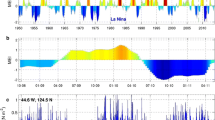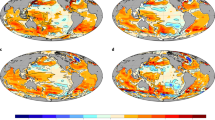Abstract
An assessment of the trends and patterns of sea surface temperatures in the North Atlantic Ocean was carried out using statistical methods. The data were obtained from the climate research unit, comprising twenty-five 5 by 10° regions, covering latitudes 40 to 65°N and longitudes 10 to 60°W between 1973 and 2008. Linear regression was initially used to model the seasonally adjusted sea surface temperatures. The data was filtered with a second order autoregressive process to remove autocorrelations between temperature lags. A multivariate linear regression model was then fit to the data to account for the spatial correlation, giving the covariance matrix of the estimated slopes. A three-factor model was fit to the covariance matrix to form three larger regions. A spline linear regression model with one knot at 1990 was then fit to these three regions. The temperatures in these three regions were found to increase by approximately 0.13 °C per decade during 1973–1989. During 1990–2008, the increase in temperatures in the two of three larger regions identified by the factors analysis was at least 0.40 °C per decade.







Similar content being viewed by others
References
Battisti DS, Bhatt US, Alexander MA (1995) A modeling study of the interannual variability in the wintertime North Atlantic Ocean. J Climate 8:3067–3083
Borzelli G, Ligi R (1999) Empirical orthogonal function analysis of SST image series: a physical interpretation. J Atmos Ocean Technol 16:682–690
Catiaux J, Vautard R, Yiou P (2011) North-Atlantic SST amplified recent wintertime European land temperature extremes and trends. Clim Dyn 36:2113–2128
CRU (2009) Climatic Research Unit, http://www.cru.uea.ac.uk/cru/data/temperature. Accessed 1 April 2010
Desser C, Blackmon ML (1993) Surface climate variations over the North Atlantic Ocean during winter: 1900–1989. J Climate 6:1743–1753
Emanuel KA (1987) The dependence of hurricane intensity on climate. Nature 326:483–485
Greville TNE (1969) Introduction to Spline Functions. In: Grevillea TNE (ed) Theory and Applications to Spline Functions. Academic, New York
Hansen DV, Bezdek HF (1996) On the nature of decadal anomalies in North Atlantic sea surface temperature. J Geophys Res 101:8749–8758
Hebert PDN, Matlock M (2010) Atlantic Ocean, In: Encyclopedia of Earth. Eds. Cutler J. Cleveland, Biodiversity Institute of Ontario. http://www.eoearth.org/article/Atlantic_Ocean. Accessed 30 August 2011
Higham NJ (2002) Accuracy and stability of numerical algorithms, 2ed. Philadelphia
Holland GJ (1997) The maximum potential intensity of tropical cyclones. J Atmos Sci 54:2519–2541
Holland GJ, Webster PJ (2007) Heightened tropical cyclone activity in the North Atlantic: natural variability or climate trend? Roy Soc 365:2695–2716
Houghton RW (1996) Subsurface quasi-decal fluctuations in the North Atlantic. J Climate 9:1361–1373
Kim JH, Rimbu N, Lorenz SJ, Lohmann G, Nam SI, Schouten S, Rűhlemann C, Schneider RR (2004) North Pacific and North Atlantic sea surface temperature variability during the Holocene. Quat Sci Rev 23:2141–2154
Knight JR, Folland CK, Scaife AA (2006) Climate impacts of the Atlantic multidecadal oscillation. Geophys Res Lett 33(17), L17706
Knutson TR, Sirutis JJ, Garner ST, Vecchi GA, Held IM (2008) Simulated reduction in Atlantic hurricane frequency under twenty-first century warming conditions. Nat Geosci 1:359–364
Lee KL, Shen SSP, Bailey B (2009) Factor analysis for El Nino signals in sea surface temperature and precipitation. Theor App Climatol 97:195–203
Marshall J, Kushnir Y, Battisti D, Chang P, Czaja A, Dickson R, Hurrell J, McCartney M, Saravanan R, Visbeck M (2001) North Atlantic climate variability: phenomena, impacts, and mechanisms. Int J Climatol 21:1863–1898
McNeil N, Odton T, Ueranantasun A (2011) Spline interpolation of demographic data revisited. Songklanakarin J Sci Technol 33(1):117–120
Polyakov IV, Alexeev VA, Bhatt US, Polyakova EI, Zhang X (2010) North Atlantic warming: patterns of long-term trend and multidecadal variability. Clim Dyn 34:439–457
Qu T, Du Y, Strachan J, Meyers G, Slingo J (2005) Sea surface temperature and its variability in the Indonesian region. Oceanography 18(4):50–61
R Development Core Team (2008) R: A language and environment for statistical computing. R Foundation for Statistical Computing, Vienna
Rossby T (1996) The North Atlantic current and surrounding waters: at the crossroads. Rev Geophys 34:463–481
Rudels B, Friedrich HJ, Quadfasel D (1999) The arctic circumpolar boundary current. Deep-Sea Res 46:1023–1062
Saunders MA, Lea AS (2008) Large contribution of sea surface warming to recent increase in Atlantic hurricane activity. Nature 451:557–560
Sutton RT, Allen MR (1997) Decadal predictability to north Atlantic sea surface temperature and climate. Nature 388:563–567
Ting M, Kushnir Y, Seager R, Li C (2009) Forced and internal twentieth century SST trends in the North Atlantic. J Clim 22(6):1469–1481
Venables WN, Ripley BD (2002) Modern Applied Statistics with S. Springer, Queensland
Werner PC, Gerstengarbe FW, Fraedrich K, Oesterle H (2000) Recent climate change in the North Atlantic/European sector. Int J Climatol 20:463–471
Woodgate RA, Fahrbach E, Rohardt G (1999) Structure and transport of the East Greenland current at 75°N from moored current meters. J Geophys Res 104:18059–18072
Xie SP, Deser C, Vecchi GA, Ma J, Teng H, Wettenberg AT (2009) Global warming pattern formation: sea surface temperate and rainfall. J Climate 23:966–986
Acknowledgment
We are grateful for Prof Don McNeil for his helpful suggestions.
Author information
Authors and Affiliations
Corresponding author
Rights and permissions
About this article
Cite this article
McNeil, N., Chooprateep, S. Modeling sea surface temperatures of the North Atlantic Ocean. Theor Appl Climatol 116, 11–17 (2014). https://doi.org/10.1007/s00704-013-0930-0
Received:
Accepted:
Published:
Issue Date:
DOI: https://doi.org/10.1007/s00704-013-0930-0




